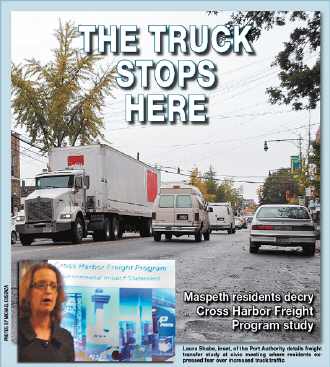As outlined in the document, the primary purpose of the Cross Harbor project “is to improve the movement of freight across New York Harbor between the east-of-Hudson and west-of-Hudson regions.”
“Things cost more here because of transportation inefficiencies,” Shabe noted. “The result is an increase in costs and problems for us as we maintain our quality of life.”
The four goals of the project are: reduce the contribution of Cross Harbor truck trips to congestion along the region’s major freight corridors; provide Cross Harbor freight shippers, receivers and carriers with additional, attractive modal options to existing interstate trucking services; expand facilities for Cross Harbor goods movement to enhance system safety, security and infrastructure protection; and support development of integrated freight transportation and land use strategies.
The three options in play, Shabe stated, are No Action, Transportation Demand Management and Build. No Action would only include projects in the area that are already planned, programmed or underway, independent of the Cross Harbor program. Management involves low-cost, low-impact improvements to the existing transportation network. And the Build option refers to implementing new infrustructure such as a float/ferry system or rail tunnel.
For many in attendance Tuesday night, the latter recalled the 2004 proposal by the city Economic Development Corp., FHWA and Federal Railroad Administration for a Cross Harbor tunnel, which would connect railyards in New Jersey to Brooklyn and Queens.
The tunnel plan, which was suspended after public hearings, would have had freight carried by rail to the Fresh Pond Yards in Glendale and the Maspeth Yards on Rust Street, where an intermodal terminal would allow it to be trucked out of the area to the city and Long Island.
“I don’t support any plan that would put an intermodal terminal in Maspeth,” City Councilwoman Elizabeth Crowley (D-Middle Village) said. “We already have a tremendous amount of truck traffic.”
Many longtime Maspeth residents delivered impassioned remarks, vocalizing their frustration with any plan that would involve more rail and truck presence in the community.
“How much does the city want to dump on Maspeth?” asked Linda D’Aquaro, whose son is asthmatic. “If you have alternative sites, why don’t you take it there? We’re already suffering.”
Manny Caruana highlighted what he and others believed is the need for the agencies involved in the project to take a particularly closer look at all maritime options.
“The impact on the surrounding community is going to be horrendous, because we’re going to be inundated with smaller trucks,” he said. “Transport it by water — you don’t need ten billion studies.”
Robert Conway, a consultant on the project, said that while he understood the community’s concerns, the current stagnant state of freight movement in the region makes change in any capacity a necessity.
“Right now you have an inefficient highway and rail system that are causing all these problems,” he related. “If we don’t do anything it’s only going to get worse.”


